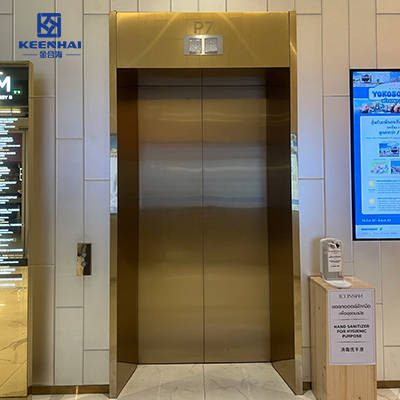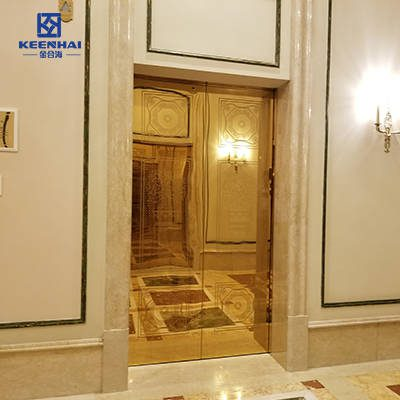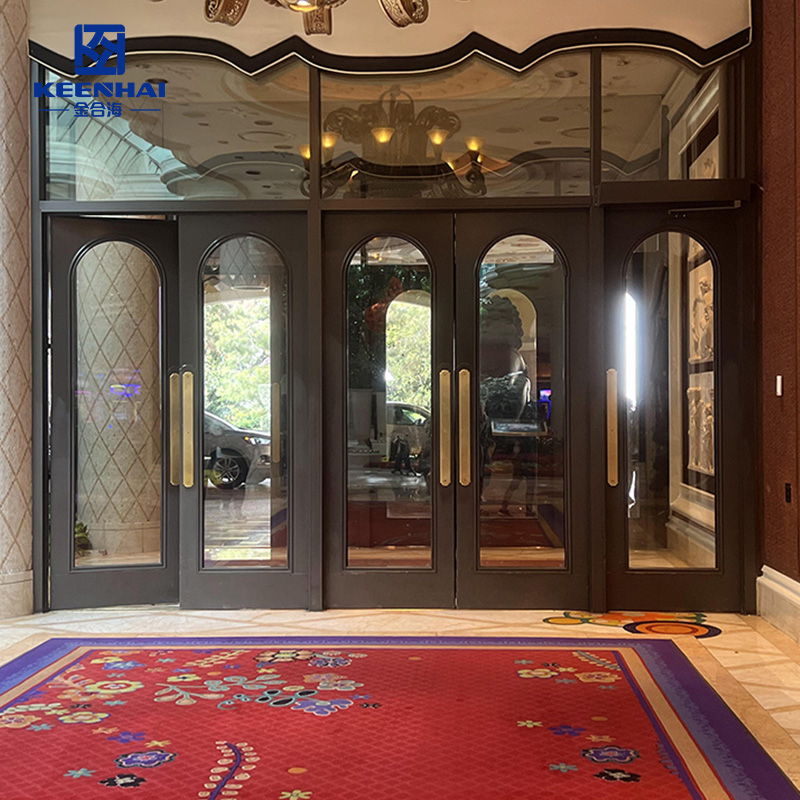PVD stainless steel sheets provide exceptional corrosion resistance and scratch-proof surfaces, making them ideal for exterior facades, roofing, and interior design. Architects use them in high-traffic areas like lobbies and elevators because they maintain color consistency and surface integrity even under heavy use, ensuring projects stay visually striking for decades.
1.Exterior Applications
1.1 Facade Cladding and Wall Panels
PVD stainless steel sheets have become a go-to material for modern building facades due to their exceptional durability and aesthetic flexibility. Architects often choose premium stainless steel panels for exterior walls because they resist corrosion in coastal and urban environments while maintaining a consistent finish over decades. These panels can be cut and shaped to fit intricate designs, from flat large-scale cladding to textured architectural accents. A notable benefit is the minimal maintenance required—periodic cleaning with mild detergents preserves their sheen without the need for repainting or protective coatings.
1.2 Roof and Canopy Surfaces
Beyond walls, PVD-coated stainless steel excels in roofing and canopy applications. Its high tensile strength and resistance to UV degradation make it ideal for structures exposed to direct sunlight and heavy rainfall. For instance, commercial buildings in high-precipitation regions use PVD sheets on canopy surfaces to prevent rust streaks and water marks that often plague traditional metal roofs. Installation follows three key steps:
-
Measure and cut the sheets precisely to fit roof geometry.
-
Secure panels with corrosion-resistant fasteners, allowing for thermal expansion.
-
Seal edges with compatible waterproof membranes to prevent leakage.
The result is a long-lasting, visually striking canopy that complements the building’s design without frequent maintenance.
1.3 Weather and Corrosion Considerations
When comparing exterior materials, PVD stainless steel consistently outperforms standard stainless steel and electroplated options in terms of weather resistance. In accelerated corrosion tests, PVD panels maintain structural integrity for over 1,000 hours in salt spray environments, while traditional finishes show pitting and discoloration much sooner. The following table illustrates a typical comparison for high-grade exterior sheets:
| Ерекшелік | PVD Stainless Steel | Electroplated Steel | Powder-Coated Steel |
|---|---|---|---|
| Salt Spray Resistance | >1000 hrs | 250–400 hrs | 500–700 hrs |
| Scratch Resistance | 2500–3000 HV | 1000–1500 HV | 800–1000 HV |
| Color Stability | 10–15 years | 3–5 years | 5–7 years |
Additionally, using Тот баспайтын болаттан жасалған сыртқы қабырға panels in urban environments reduces long-term maintenance costs and preserves the building’s modern look even in polluted or coastal areas. The combination of PVD technology and superior sheet design ensures a consistent reflective surface, excellent corrosion resistance, and high structural integrity, making it a preferred choice for architects and developers.

2.Interior Applications
2.1 Elevator Panels and Lobbies
PVD stainless steel sheets are widely used in elevator panels and lobbies due to their scratch resistance, color stability, and premium finish. Designers favor PVD coated stainless steel for high-traffic areas because it resists fingerprints and abrasions, maintaining a polished look over years of constant use. Installation typically involves:
-
Measuring elevator panel dimensions precisely.
-
Attaching panels with non-corrosive fasteners to ensure a flush, seamless surface.
-
Sealing edges and corners with decorative trim for aesthetic continuity.
This application is especially popular in hotels, office towers, and luxury residential buildings, where visual appeal and durability are equally critical.
2.2 Wall Coverings and Decorative Elements
Interior walls and decorative features benefit from the flexibility of PVD stainless steel sheets. They can be laser-cut into intricate patterns, embossed, or combined with glass and stone to create a modern, elegant look. In addition, their low maintenance and resistance to fading make them ideal for corridors, conference rooms, and atriums. Architects often choose premium stainless steel panels when designing high-visibility areas, as these panels maintain their reflective surface and metallic tones for over a decade, even under artificial lighting and daily wear.
2.3 Handrails, Fixtures, and Furniture Accents
PVD-coated stainless steel is a top choice for handrails, fixtures, and furniture accents due to its high hardness and corrosion resistance. For example, stainless steel handrails in coastal hotels withstand continuous exposure to humidity and cleaning agents without tarnishing. When comparing surface performance across interior materials, PVD sheets consistently outperform traditional stainless steel and powder-coated options:
| Ерекшелік | PVD Stainless Steel | Traditional Stainless Steel | Powder-Coated Steel |
|---|---|---|---|
| Scratch Resistance | 2500–3000 HV | 1200–1500 HV | 800–1000 HV |
| Fingerprint Resistance | Жоғары | Орташа | Төмен |
| Color Stability | 10–15 years | 3–5 years | 5–7 years |
| Maintenance Frequency | Төмен | Орташа | Жоғары |
These applications extend to cabinet panels, table accents, and elevator buttons, providing both functional durability and high-end aesthetics. Using PVD surfaces in interiors ensures long-term appearance retention while minimizing the need for constant maintenance, making it a favorite among interior designers and facility managers.

3.Design and Finish Options
3.1 Color Variety and Customization
PVD stainless steel sheets offer an impressive range of colors, from classic gold, bronze, and silver to deep blacks and metallic blues. Designers can select custom shades to match branding or interior schemes, making them ideal for hotel lobbies, office spaces, and commercial storefronts. The PVD process ensures color consistency and long-term stability, even under harsh lighting or high-traffic environments. For high-visibility applications, architects often choose premium PVD coated stainless steel panels to achieve both durability and visual impact without worrying about fading or discoloration.
3.2 Surface Textures: Brushed, Mirror, Matte
Surface finishing plays a key role in design flexibility. PVD sheets can be processed into:
-
Brushed finishes for subtle texture that hides fingerprints and minor scratches.
-
Mirror finishes for reflective, high-gloss surfaces that enhance lighting effects in lobbies or atriums.
-
Matte finishes for a modern, understated elegance.
These options allow designers to integrate metallic elements seamlessly into both traditional and contemporary interiors. For example, brushed stainless steel sheets are commonly used in elevator panels, while mirror finishes highlight feature walls or decorative ceilings.
3.3 Integration with Glass, Wood, and Concrete
One of the biggest advantages of PVD stainless steel is its compatibility with other materials. It can be combined with glass for modern partition walls, with wood for luxury furniture accents, or with concrete in industrial-style interiors. The panels can be cut, bent, or embossed to fit precise design requirements. In many commercial projects, designers use PVD elements as contrast highlights, such as metallic trims on concrete staircases or accent panels behind glass reception desks, to enhance both aesthetics and longevity.

4.Performance and Durability
4.1 Scratch and Wear Resistance
PVD stainless steel sheets deliver exceptional hardness, typically ranging from 2500–3000 HV, which significantly reduces surface scratches compared with traditional stainless steel or powder-coated alternatives. This makes them ideal for elevator panels, handrails, and frequently touched surfaces in commercial and residential buildings. When selecting PVD finishes, designers consider both color and texture to maximize scratch concealment, ensuring panels retain their premium look even in high-traffic areas. For example, brushed or matte stainless steel sheets are often chosen for corridors to minimize visible wear.
4.2 Long-Term Corrosion Resistance
One of the key advantages of PVD stainless steel is its superior resistance to corrosion and environmental degradation. The thin, dense coating protects the substrate from moisture, salts, and cleaning chemicals, extending service life well beyond 15 years in typical building environments. Coastal or humid interiors benefit most, as PVD panels maintain both structural integrity and color vibrancy. Below is a comparison highlighting performance differences:
| Ерекшелік | PVD Stainless Steel | Traditional Stainless Steel | Powder-Coated Steel |
|---|---|---|---|
| Коррозияға төзімділік | Very High | Орташа | Төмен |
| Surface Longevity | 15+ years | 5–7 years | 3–5 years |
| Color Stability | Excellent | Moderate | Moderate |
| Cleaning Frequency | Төмен | Орташа | Жоғары |
This data demonstrates why designers increasingly select PVD surfaces for facades, interior accents, and architectural elements exposed to varying climates.
4.3 Maintenance and Cleaning Requirements
PVD stainless steel requires minimal maintenance, making it highly practical for both commercial and residential projects. Routine cleaning involves:
-
Wiping with a soft microfiber cloth to remove dust and fingerprints.
-
Using mild, non-abrasive cleaners for stubborn stains.
-
Avoiding harsh chemicals or steel wool, which can damage the PVD layer.
Thanks to its durability and low-maintenance characteristics, PVD coated stainless steel remains visually striking for years without the frequent upkeep needed for traditional materials, reducing long-term operational costs while maintaining an elegant, professional finish.
PVD stainless steel sheets combine durability, aesthetic versatility, and minimal maintenance, making them a top choice for modern architecture. From sleek elevator panels to weather-resistant exterior walls, these sheets deliver long-lasting performance and visual appeal. Their ability to integrate with glass, wood, and concrete ensures architects can achieve both functional and design objectives without compromise.







